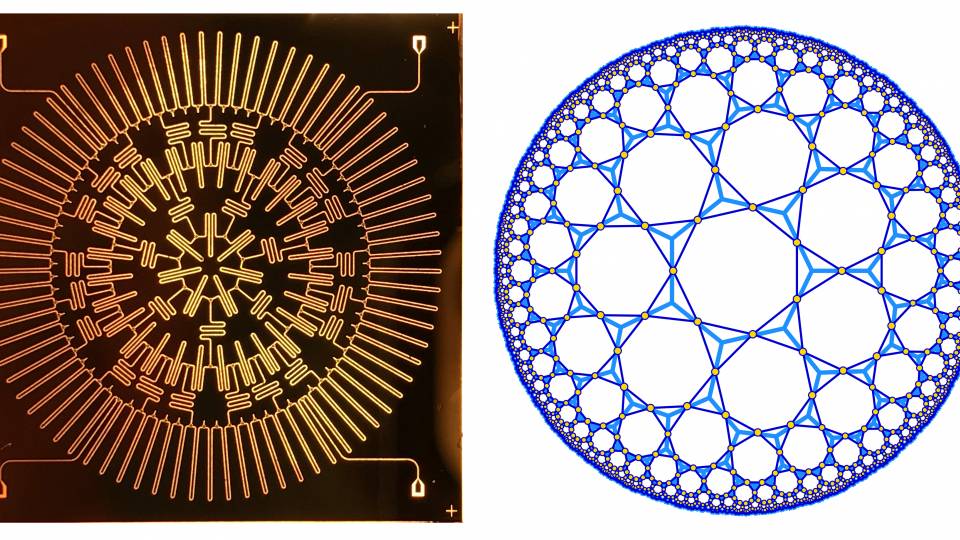A Princeton scientist with an interdisciplinary bent has taken two well-known problems in mathematics and reformulated them as a physics question, offering new tools to solve challenges relevant to a host of subjects ranging from improving data compression to detecting gravitational waves.
Salvatore Torquato, a professor of chemistry, has shown that two abstract puzzles in geometry -- known as the "covering" and "quantizer" problems -- can be recast as "ground state" problems in physics. Ground state problems relate to the study of molecule systems at their lowest levels of energy and have numerous applications across scientific disciplines. Torquato's conclusions are reported in a paper that was published online Nov. 10 by Physical Review E.
"This paper describes what I believe to be a wonderful example of the deep interplay between geometry and physics," Torquato said. The problem of determining the ground states of special interacting particles, which is relevant to studies of conditions of materials approaching absolute zero, is directly applicable to these math questions, he explained.
"In other words," Torquato said, "what appear to be abstract mathematical problems can be related to the cooling of special liquids that undergo phase transitions to crystal states at a temperature of absolute zero. These reformulations are completely new to my knowledge."
The interdisciplinary nature of the study reflects Torquato's wide-ranging research expertise. He also is a faculty member at the Princeton Institute for the Science and Technology of Materials, a senior faculty fellow at the Princeton Center for Theoretical Science and an associated faculty member in Princeton's Department of Physics, Program in Applied and Computational Mathematics and Department of Mechanical and Aerospace Engineering.
The covering problem refers to a quandary in mathematics that employs geometrical principles to understand the most efficient way to arrange overlapping spheres so that they cover the maximum amount of space. The covering problem has applications in wireless communication network layouts, search templates for gravitational waves and some forms of radiation therapy.
The quantizer problem is concerned with finding an optimal point configuration. The problem comes into play when mathematicians attempt to reduce what is known as a "distance error." This occurs, for example, when researchers are devising data compression techniques. They want to find the most efficient way to convey large amounts of data. They also must represent the information contained within it as accurately as possible. In these problems, fractional numbers representing data points are rounded off to the nearest point of an underlying array of points representing the optimal configuration, resulting in the distance errors.
In addition to providing solutions for data compression, the approach offers answers to other aspects of computer science bearing upon digital communications, particularly coding and cryptography, and numerical methods involving partial differential equations.
Torquato started on his new approach after learning from a colleague about the quantizer problem and seeing parallels with other studies on the ground state in physics. He already was familiar with the covering problem because of his interest in sphere-packing puzzles.
The covering and quantizer problems are major problems in discrete mathematics and information theory, according to Henry Cohn, a mathematician with Microsoft Research New England in Cambridge, Mass. These quandaries have, however, received much less attention than related problems such as packing, Cohn said, because "they seem to be far more subtle and complicated and thus much more difficult to study."
Torquato's study, he added, develops the theory from a physics perspective and builds new connections with the theory of energy minimization and ground states.
"One consequence is new insights into the role of randomness and disorder," Cohn said. "I'm also intrigued by the potential use for detecting gravitational waves, which would be a remarkable application of mathematics."
Tackling the problem
As a starting point, Torquato knew that covering and quantizer problems could be considered optimization problems, in which researchers attempt to either minimize or maximize a particular function. For example, in the covering problem, the idea is to find the best possible array of points in overlapping spheres that cover the maximum amount of space. In the quantizer problem, the goal is to minimize the errors inherent in rounding off "nasty numbers," according to Torquato.
The breakthrough came when he recognized that the covering and quantizer problems could be cast as energy minimization or ground state problems in any space dimension. In such problems, a researcher attempts to find an optimal arrangement of molecules (or points) that minimizes the total energy of all the particles in the system. This is a difficult task in general because the interactions or forces a molecule experiences due to all of the other molecules is very complex and the resulting patterns are challenging to predict.
In thinking about particles close to absolute zero, Torquato knew that these particles were in their ground state and represented the perfect array for energy minimization. He realized that the point arrays being studied in covering and quantizer problems could also be described as interacting systems of particles. Finding the ground states for those interacting particle systems, he further realized, would represent the best solution to the covering and quantizer problems.
In the paper, Torquato also has drawn connections to two other seemingly different but important mathematical conundrums, including the sphere-packing problem and the density-fluctuation (number variance) problem, the latter of which is related to a classical problem in number theory. The sphere-packing problem asks for the densest arrangements of spheres, which is a notoriously difficult problem. The renowned mathematician and astronomer Johannes Kepler proposed what he viewed as the best solution in 1611. It has only been in the last few years that researchers have devised a proof of Kepler's conjecture.
"These results may have important implications across many fields, which speaks to the fundamental nature of the problems," Torquato added.
One of the more intriguing possible applications to his work would be in helping to develop search templates for gravitational waves.
Gravitational waves are ripples in the structure of space-time, which may occur individually or as continuous radiation. According to Einstein's Theory of General Relativity, they are emitted when extremely massive objects, such as black holes, experience sudden accelerations or changes of shape. While in theory they travel through space at the speed of light, gravitational waves remain undetected.
"The problem of the detection of gravitational waves is a huge problem in astrophysics," Torquato said. Scientists attempting to analyze data from currently existing gravitational wave detectors may be able to use the insights from his paper to design software tools for more accurate searches through high-dimensional data sets, Torquato said.
The work builds on his approach to the sphere-packing problem. In August 2009, Torquato and Yang Jiao, now a postdoctoral fellow at Princeton, made a major advance in addressing a twist on a longstanding packing problem, jamming more tetrahedra -- solid figures with four triangular faces -- and other polyhedral solid objects than ever before into a space.
The current study was supported by the Office of Basic Energy Sciences of the U.S. Department of Energy.

